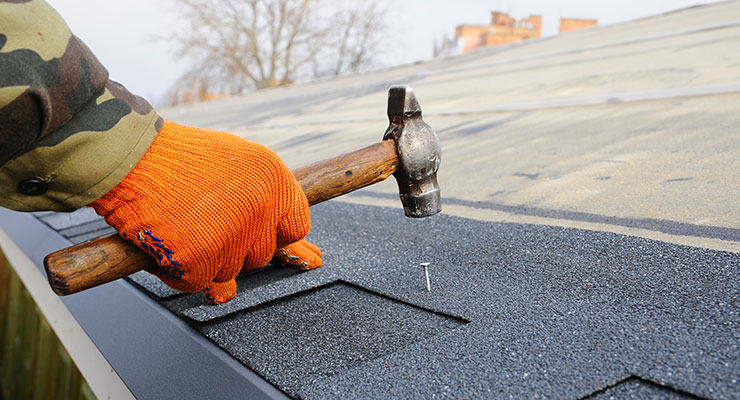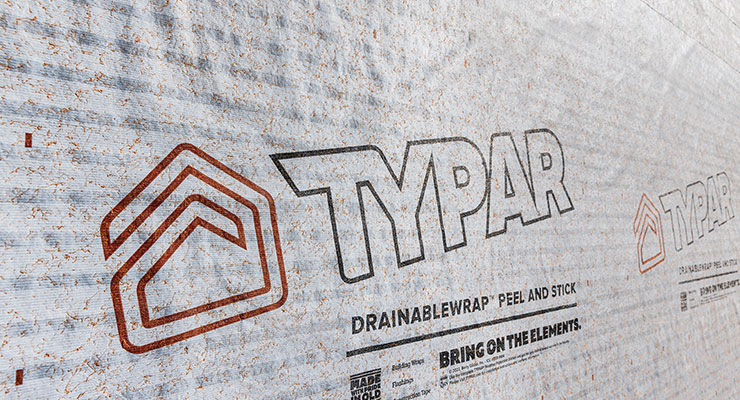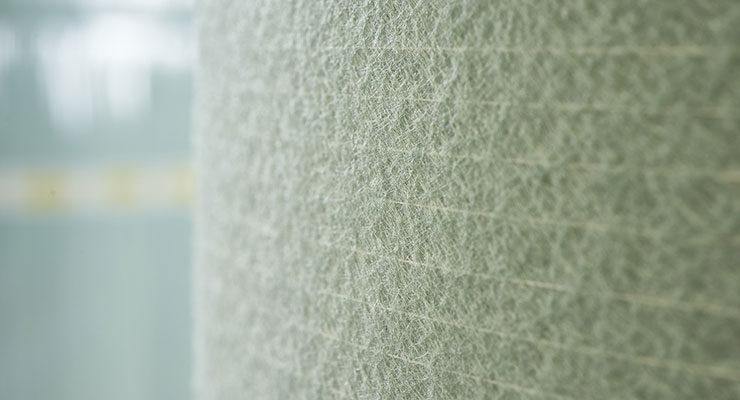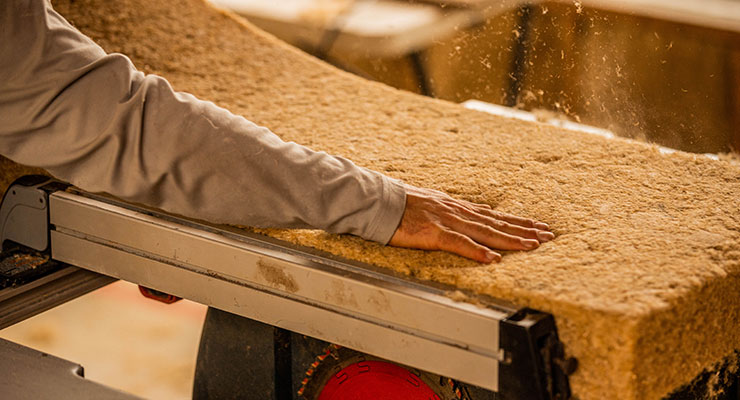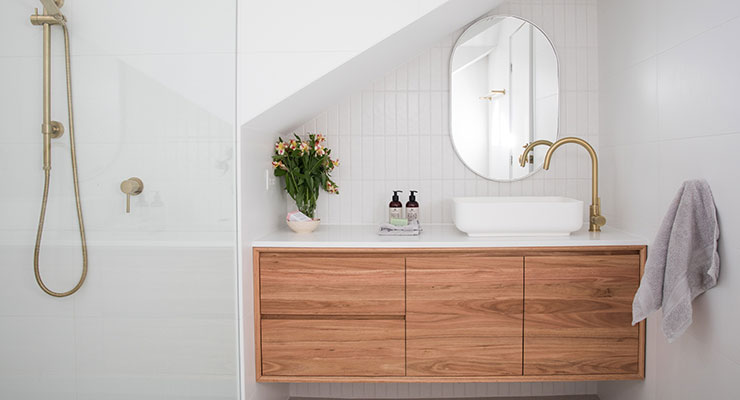Tara Olivo, Associate Editor03.29.23
Construction is one of the largest durable markets for nonwovens, and the materials continue to be an essential part of the structure of homes and buildings. Known for their durability and versatility, nonwovens provide solutions for house and building wrap, roofing, window flashing, ceilings, flooring, gypsum wall board, insulation and wall coverings, among other areas. Nonwovens Industry spoke to some of the key suppliers of nonwovens for roofing and construction to get an update on their latest technologies.
In December the company launched Typar DrainableWrap Peel and Stick, a self-adhering building wrap, pairing the unique drainage benefits of Typar DrainableWrap with the ease and speedy installation of a peel-and-stick application. “Because it does not require fasteners to install—which can serve as potential entry points for air and water infiltration—Typar DrainableWrap Peel and Stick can provide a tighter building envelope,” says Andrew Irvine, product manager, Typar.
DrainableWrap Peel and Stick can shed more bulk water than traditional house wraps and offers the added efficiency of an integrated drainage plane. The science behind the product is a layer of multi-directional fibers that diverts bulk water from exterior wall cavities and drains it away from the assembly—preventing the potential damage caused by mold and rot.
Available in 4’10” by 100’ rolls, DrainableWrap Peel and Stick covers more area than average peel and stick wraps and can be installed in any direction without affecting performance. Additionally, it offers a wide cold temperature range and can be installed at temperatures as low as 10°F (-12°C).
Another new offering is Typar DrainableWrap Commercial, which brings high-performance drainability to a commercial-grade building wrap. DrainableWrap Commercial is the company’s first drainable building wrap engineered to protect multi-story structures from the elements and manage excess moisture.
“Supporting the commercial market has always been important to Typar, and the addition of DrainableWrap Commercial is further proof of that commitment,” says Irvine. “This new commercial wrap offers the superior UV protection and tear strength needed for commercial job sites while also helping commercial builders and architects address the growing challenge of drainage in high-rise building envelopes.”
DrainableWrap Commercial, available in 5’ by 150’ rolls, offers an elevated ability to deal with excess moisture even faster than most conventional house wraps. This is thanks to Typar patented meltshot technology, which adds an integrated layer of fibers to create an effective drainage gap to channel wind-driven rain and bulk water away from the structure.
DrainableWrap Commercial can be installed as part of the Typar Weather Protection System, which encompasses the company’s full line of high-performance house wraps, tapes and accessories. The system perfectly balances water and air holdout with the ideal level of moisture vapor transmission while also improving the building’s overall energy efficiency. When installed together, the complete Typar Weather Protection System is covered by the only lifetime limited warranty in the industry that includes materials and labor.
By all accounts, Irving says the commercial construction market is healthy, and they expect activity to remain strong through next year. “Berry Global is committed to supporting continued growth in this sector, as is evident in the launch of new products like Typar DrainableWrap Commercial. While residential construction still has some challenges, we are seeing signs of improvement and expect to see increased growth in the coming months.”
According to Dr. Frank Heislitz, CEO, Freudenberg Performance Materials, the use of nonwovens in construction applications is growing and the market continues to develop products able to add value for the final user. “This growth can be attributed to the continuous innovations and to new ways to apply nonwovens in the construction industry thanks to their different features. A new generation of ‘composite technology’ is finding new applications to improve the protection of the building as well as the quality of the life inside in the living area,” he says.
Within the roofing and construction market, Freudenberg also expects there to be increasing attention on sustainability projects, considered a strategic trend, aimed at reducing energy consumption and environmental impact and at developing more and more eco-friendly products.
Recently, Freudenberg upgraded a production line for staple nonwovens in one of its Italian sites to increase production volumes and at the same time to provide additional flexibility by offering the possibility to develop and produce new specialty products.
Most of Freudenberg’s nonwovens are manufactured using 100% post-consumer recycled PET that helps limit the consumption of natural resources and guarantees a reduced environmental impact.
The company’s broad technology platform allows it to provide various innovative materials. In addition to a one-step-production process, Freudenberg also manufactures polyester nonwovens with a unique two-step-process solution allowing the company to be even more flexible. Thanks to its state-of-the-art technologies, Freudenberg’s experts can manufacture highly functional materials for even the most demanding requirements.
According to Dr. Heislitz, the trend of the construction market is strictly linked to the worldwide economic situation. “After the Covid pandemic, Freudenberg experienced a high growth of the market thanks to the generation of ‘spin-off’ effects that created jobs, thus contributing to the recovery of local economies, and to tax incentives issued by the single governments,” he explains. “In 2022, main problems were the energy and raw materials crisis. This supply chain effect caused worldwide shortages affecting production and transport. Despite this economic uncertainty and the different situation of the economies of world countries, the market of nonwovens continues to develop products able to add value to the final user.”
For JM, most product developments are carried out together with individual customers. “During the recent times of supply bottlenecks, we strived for cross-continental product qualifications with the aim of making nonwoven products from our European plants available in North America and vice versa,” he explains.
JM is constantly optimizing and upgrading its global production facilities. According to Kleinebrecht, its projects in this area usually involve significant capital investments and focus on sustainability, quality and productivity. “Today we offer products with a high post-consumer recycled content, bio-based components, and formaldehyde-free binder systems,” he says. “Over many years we were able to successfully reduce the CO2 emissions in our own fiberglass production and landfilling from our production-waste.”
An example of this is the company’s €10 million investment in a thermal recycling unit in Trnava, Slovakia, with which it recycles almost all fiber production waste and guarantees an average rate of 6% recycled content in all glass products at the site. In addition to external sales, Trnava fiberglass is also used for its own glass nonwoven production at the German sites in Wertheim and Steinach.
“It is equally important to support our customers in their sustainability projects,” he says. “This leads to success, for example, if with our products we can help them reduce their consumption of raw materials, minimize their use of energy through an increase in productivity or achieve a higher proportion of reused or renewable raw materials in their own products.”
The new 33,000-square-foot energy efficient facility produces a wide range of bio-based nonwoven products, with hemp fiber being the primary component, using a custom-designed manufacturing process exclusive to Hempitecture. The unique line configuration works with natural fibers to create a wide range of products for multiple industries. Products include sustainable liners for cold freight partners who serve industries such as meal delivery services and the pharmaceutical industry, and HempWool Thermal Insulation, a sustainable, bio-based high-performing building insulation material that is fire resistant, safe to touch and carbon negative.
The hemp fiber used for production is sourced locally from Hempitecture’s partner, IND Hemp, located in Montana. Hempitecture partnered with Dell’Orco and Villani for its opening and blending line and with Technoplants for its high-loft airlay and thermobonding line.
With an increased demand for U.S.-grown and U.S.-manufactured products, Hempitecture’s facility creates a necessary natural fiber bio-based supply chain that lowers the carbon footprint for making sustainable building and insulation materials.
“Since the onset of the pandemic, we’ve seen more people turn their attention toward healthy homes and environments,” says Hempitecture CEO and founder Mattie Mead. “This new facility will allow for a fully U.S.-made product which aids in growing Hempitecture’s reach across residential, commercial and multi-family markets, making healthy products and home building more tangible.”
According to Mead, the earliest concept of Hempitecture was focused around industrial hemp, but not so much the fiber. Early on the company utilized a bio-composite building material called hemp lime or hempcrete, which uses the inner woody core of the hemp stalk. As the business matured, Hempitecture transitioned from hempcrete/hemp lime to HempWool, its insulation product that uses the bast fiber.
While Mead says there are many other great bast fiber crops out there, one thing that makes industrial hemp so compelling is that it is a rapidly renewable resource that can be grown in a variety of climate types and in a variety of regions across the U.S. Also, during its three- to four-month cultivation cycle, it offsets about 9.8 tons of CO2 per acre. “It does that more so than any other bast fiber crops while also requiring less inputs than some other fiber producing crops, making it a truly sustainable, rapidly renewable resource,” he explains. “The fiber itself, when grown with the proper genetics and processed properly, also produces a fiber that is very strong. It has a variety of benefits due to its somewhat porous structure. The porous structure of industrial hemp fiber actually in part lends to the insulative capacity of the fiber itself.”
Today, HempWool is the only USDA Certified Biobased insulation product on the market. “Whereas other insulation companies are using non-biodegradable or abrasive VOC-containing raw materials in their formulation, we’re using plant fiber and we’re using a binder, so it’s a pretty simple formulation: safe to touch, safe to handle and causes no respiratory harm,” Mead says.
On the other hand, lightly touching an insulation product made with fiberglass puts fiber shards in the skin and irritates the mucus membrane, he adds. “HempWool is the epitome of a healthy and sustainable product, and we’re seeing a lot of interest in the insulation industry to move towards more sustainable, healthy products. However, the products from the companies that are the biggest stakeholders for insulation are inherently not healthy and inherently not sustainable, so we really have that at our core.”
While other insulation products come from non-renewable or carbon intensive resources, Hempitecture’s are coming from plant-based resources. “By coming from plant-based resources, we’re supporting rural communities and rural economies, particularly across the Rocky Mountain West where we’re based in our supply chain, and we like to think our benefit transcends the product we’re producing and the home that it’s going into. It is supporting rural economies that really have been overlooked,” Mead says.
“Our high performance solutions for plasterboards deliver excellent fire and moisture resistance,” says Pierre Mary, vice president, Nonwovens. “Delivering protection against flame spread, protecting against moisture and producing no mold growth in wet and humid environments, ensuring better indoor air quality.”
“Our extensive and sustainable product range also reduces environmental impact through options for formaldehyde and fluorocarbon free solutions, decreasing the use of chemicals,” adds Pekka Helynranta, vice president, Glass Fiber Tissue. “Our unique manufacturing and technological platforms enable flexible product development delivering customized solutions tailor-made to customer’s needs,” Mary and Helynranta conclude.
FibRoc Plasterboard offers a wide range of solutions for different application areas: Interior—Fire Resistance, Interior—Moisture Resistance, Semi Exterior—Fire and Moisture Resistance, Exterior—Fire and Moisture Resistance. Ahlstrom has supplied products to the building and construction industry for over 40 years. The company launched its FibRoc range in 2020, first with the FibRoc Flooring product portfolio that consists of a wide range of high-performance fiber-based solutions for heavy duty, cushion vinyl and luxury vinyl flooring, as well as solutions for carpets and carpet tiles. In 2021, Ahlstrom unveiled FibRoc Ceiling, a range of fiber-based solutions for perforated plasterboard ceilings, mineral wool and wet felt ceilings, as well as perforated wood and metal ceilings.
Berry Global
In the last several months Berry Global has expanded its offerings in the construction market with its Typar DrainableWrap line, which combines the advantages of its weather-beating material with the ability to shed excess water.In December the company launched Typar DrainableWrap Peel and Stick, a self-adhering building wrap, pairing the unique drainage benefits of Typar DrainableWrap with the ease and speedy installation of a peel-and-stick application. “Because it does not require fasteners to install—which can serve as potential entry points for air and water infiltration—Typar DrainableWrap Peel and Stick can provide a tighter building envelope,” says Andrew Irvine, product manager, Typar.
DrainableWrap Peel and Stick can shed more bulk water than traditional house wraps and offers the added efficiency of an integrated drainage plane. The science behind the product is a layer of multi-directional fibers that diverts bulk water from exterior wall cavities and drains it away from the assembly—preventing the potential damage caused by mold and rot.
Available in 4’10” by 100’ rolls, DrainableWrap Peel and Stick covers more area than average peel and stick wraps and can be installed in any direction without affecting performance. Additionally, it offers a wide cold temperature range and can be installed at temperatures as low as 10°F (-12°C).
Another new offering is Typar DrainableWrap Commercial, which brings high-performance drainability to a commercial-grade building wrap. DrainableWrap Commercial is the company’s first drainable building wrap engineered to protect multi-story structures from the elements and manage excess moisture.
“Supporting the commercial market has always been important to Typar, and the addition of DrainableWrap Commercial is further proof of that commitment,” says Irvine. “This new commercial wrap offers the superior UV protection and tear strength needed for commercial job sites while also helping commercial builders and architects address the growing challenge of drainage in high-rise building envelopes.”
DrainableWrap Commercial, available in 5’ by 150’ rolls, offers an elevated ability to deal with excess moisture even faster than most conventional house wraps. This is thanks to Typar patented meltshot technology, which adds an integrated layer of fibers to create an effective drainage gap to channel wind-driven rain and bulk water away from the structure.
DrainableWrap Commercial can be installed as part of the Typar Weather Protection System, which encompasses the company’s full line of high-performance house wraps, tapes and accessories. The system perfectly balances water and air holdout with the ideal level of moisture vapor transmission while also improving the building’s overall energy efficiency. When installed together, the complete Typar Weather Protection System is covered by the only lifetime limited warranty in the industry that includes materials and labor.
By all accounts, Irving says the commercial construction market is healthy, and they expect activity to remain strong through next year. “Berry Global is committed to supporting continued growth in this sector, as is evident in the launch of new products like Typar DrainableWrap Commercial. While residential construction still has some challenges, we are seeing signs of improvement and expect to see increased growth in the coming months.”
Freudenberg Performance Materials
For the roofing sector, Freudenberg Performance Materials develops a wide range of high performing carrier materials for bituminous and polymer coated membranes, nonwovens and three-dimensional entangled composites for roof ventilation, anti-condensation for uninsulated metal roofs and green roof systems and components. In the construction industry, Freudenberg’s range of products comprises acoustic floor insulation, geotextiles and geogrids for the reinforcements of roads and railways, drainage of buildings and soil and many other products to protect the buildings and infrastructural objects.According to Dr. Frank Heislitz, CEO, Freudenberg Performance Materials, the use of nonwovens in construction applications is growing and the market continues to develop products able to add value for the final user. “This growth can be attributed to the continuous innovations and to new ways to apply nonwovens in the construction industry thanks to their different features. A new generation of ‘composite technology’ is finding new applications to improve the protection of the building as well as the quality of the life inside in the living area,” he says.
Within the roofing and construction market, Freudenberg also expects there to be increasing attention on sustainability projects, considered a strategic trend, aimed at reducing energy consumption and environmental impact and at developing more and more eco-friendly products.
Recently, Freudenberg upgraded a production line for staple nonwovens in one of its Italian sites to increase production volumes and at the same time to provide additional flexibility by offering the possibility to develop and produce new specialty products.
Most of Freudenberg’s nonwovens are manufactured using 100% post-consumer recycled PET that helps limit the consumption of natural resources and guarantees a reduced environmental impact.
The company’s broad technology platform allows it to provide various innovative materials. In addition to a one-step-production process, Freudenberg also manufactures polyester nonwovens with a unique two-step-process solution allowing the company to be even more flexible. Thanks to its state-of-the-art technologies, Freudenberg’s experts can manufacture highly functional materials for even the most demanding requirements.
According to Dr. Heislitz, the trend of the construction market is strictly linked to the worldwide economic situation. “After the Covid pandemic, Freudenberg experienced a high growth of the market thanks to the generation of ‘spin-off’ effects that created jobs, thus contributing to the recovery of local economies, and to tax incentives issued by the single governments,” he explains. “In 2022, main problems were the energy and raw materials crisis. This supply chain effect caused worldwide shortages affecting production and transport. Despite this economic uncertainty and the different situation of the economies of world countries, the market of nonwovens continues to develop products able to add value to the final user.”
Johns Manville
Johns Manville (JM) develops polyester spunbond and fiberglass nonwovens to the construction industry. The markets it serves range from residential and commercial roofing to gypsum, flooring, ceilings and wall coverings. “Each of these applications requires different material specifications, which we can meet thanks to the breadth of our technology fleet,” says Martin Kleinebrecht, global marketing leader, Johns Manville Engineered Products.For JM, most product developments are carried out together with individual customers. “During the recent times of supply bottlenecks, we strived for cross-continental product qualifications with the aim of making nonwoven products from our European plants available in North America and vice versa,” he explains.
JM is constantly optimizing and upgrading its global production facilities. According to Kleinebrecht, its projects in this area usually involve significant capital investments and focus on sustainability, quality and productivity. “Today we offer products with a high post-consumer recycled content, bio-based components, and formaldehyde-free binder systems,” he says. “Over many years we were able to successfully reduce the CO2 emissions in our own fiberglass production and landfilling from our production-waste.”
An example of this is the company’s €10 million investment in a thermal recycling unit in Trnava, Slovakia, with which it recycles almost all fiber production waste and guarantees an average rate of 6% recycled content in all glass products at the site. In addition to external sales, Trnava fiberglass is also used for its own glass nonwoven production at the German sites in Wertheim and Steinach.
“It is equally important to support our customers in their sustainability projects,” he says. “This leads to success, for example, if with our products we can help them reduce their consumption of raw materials, minimize their use of energy through an increase in productivity or achieve a higher proportion of reused or renewable raw materials in their own products.”
Hempitecture
New to the nonwovens industry, Hempitecture recently established the first nonwoven manufacturing facility of its kind in the U.S. in Jerome, ID. The company is a nonwoven materials manufacturer that uses biobased, carbon-capturing inputs to create healthier, high-performing products.The new 33,000-square-foot energy efficient facility produces a wide range of bio-based nonwoven products, with hemp fiber being the primary component, using a custom-designed manufacturing process exclusive to Hempitecture. The unique line configuration works with natural fibers to create a wide range of products for multiple industries. Products include sustainable liners for cold freight partners who serve industries such as meal delivery services and the pharmaceutical industry, and HempWool Thermal Insulation, a sustainable, bio-based high-performing building insulation material that is fire resistant, safe to touch and carbon negative.
The hemp fiber used for production is sourced locally from Hempitecture’s partner, IND Hemp, located in Montana. Hempitecture partnered with Dell’Orco and Villani for its opening and blending line and with Technoplants for its high-loft airlay and thermobonding line.
With an increased demand for U.S.-grown and U.S.-manufactured products, Hempitecture’s facility creates a necessary natural fiber bio-based supply chain that lowers the carbon footprint for making sustainable building and insulation materials.
“Since the onset of the pandemic, we’ve seen more people turn their attention toward healthy homes and environments,” says Hempitecture CEO and founder Mattie Mead. “This new facility will allow for a fully U.S.-made product which aids in growing Hempitecture’s reach across residential, commercial and multi-family markets, making healthy products and home building more tangible.”
According to Mead, the earliest concept of Hempitecture was focused around industrial hemp, but not so much the fiber. Early on the company utilized a bio-composite building material called hemp lime or hempcrete, which uses the inner woody core of the hemp stalk. As the business matured, Hempitecture transitioned from hempcrete/hemp lime to HempWool, its insulation product that uses the bast fiber.
While Mead says there are many other great bast fiber crops out there, one thing that makes industrial hemp so compelling is that it is a rapidly renewable resource that can be grown in a variety of climate types and in a variety of regions across the U.S. Also, during its three- to four-month cultivation cycle, it offsets about 9.8 tons of CO2 per acre. “It does that more so than any other bast fiber crops while also requiring less inputs than some other fiber producing crops, making it a truly sustainable, rapidly renewable resource,” he explains. “The fiber itself, when grown with the proper genetics and processed properly, also produces a fiber that is very strong. It has a variety of benefits due to its somewhat porous structure. The porous structure of industrial hemp fiber actually in part lends to the insulative capacity of the fiber itself.”
Today, HempWool is the only USDA Certified Biobased insulation product on the market. “Whereas other insulation companies are using non-biodegradable or abrasive VOC-containing raw materials in their formulation, we’re using plant fiber and we’re using a binder, so it’s a pretty simple formulation: safe to touch, safe to handle and causes no respiratory harm,” Mead says.
On the other hand, lightly touching an insulation product made with fiberglass puts fiber shards in the skin and irritates the mucus membrane, he adds. “HempWool is the epitome of a healthy and sustainable product, and we’re seeing a lot of interest in the insulation industry to move towards more sustainable, healthy products. However, the products from the companies that are the biggest stakeholders for insulation are inherently not healthy and inherently not sustainable, so we really have that at our core.”
While other insulation products come from non-renewable or carbon intensive resources, Hempitecture’s are coming from plant-based resources. “By coming from plant-based resources, we’re supporting rural communities and rural economies, particularly across the Rocky Mountain West where we’re based in our supply chain, and we like to think our benefit transcends the product we’re producing and the home that it’s going into. It is supporting rural economies that really have been overlooked,” Mead says.
Ahlstrom
Ahlstrom has developed a new portfolio of solutions for the plasterboard market. FibRoc Plasterboard is a new offering of protective and durable solutions for high performance plasterboard applications. What differentiates it from other solutions is that it is a combination of glass, synthetic and natural fibers, delivering excellent dimensional stability, good protection, durability and reduced environmental impact in all high-performance application areas.“Our high performance solutions for plasterboards deliver excellent fire and moisture resistance,” says Pierre Mary, vice president, Nonwovens. “Delivering protection against flame spread, protecting against moisture and producing no mold growth in wet and humid environments, ensuring better indoor air quality.”
“Our extensive and sustainable product range also reduces environmental impact through options for formaldehyde and fluorocarbon free solutions, decreasing the use of chemicals,” adds Pekka Helynranta, vice president, Glass Fiber Tissue. “Our unique manufacturing and technological platforms enable flexible product development delivering customized solutions tailor-made to customer’s needs,” Mary and Helynranta conclude.
FibRoc Plasterboard offers a wide range of solutions for different application areas: Interior—Fire Resistance, Interior—Moisture Resistance, Semi Exterior—Fire and Moisture Resistance, Exterior—Fire and Moisture Resistance. Ahlstrom has supplied products to the building and construction industry for over 40 years. The company launched its FibRoc range in 2020, first with the FibRoc Flooring product portfolio that consists of a wide range of high-performance fiber-based solutions for heavy duty, cushion vinyl and luxury vinyl flooring, as well as solutions for carpets and carpet tiles. In 2021, Ahlstrom unveiled FibRoc Ceiling, a range of fiber-based solutions for perforated plasterboard ceilings, mineral wool and wet felt ceilings, as well as perforated wood and metal ceilings.

